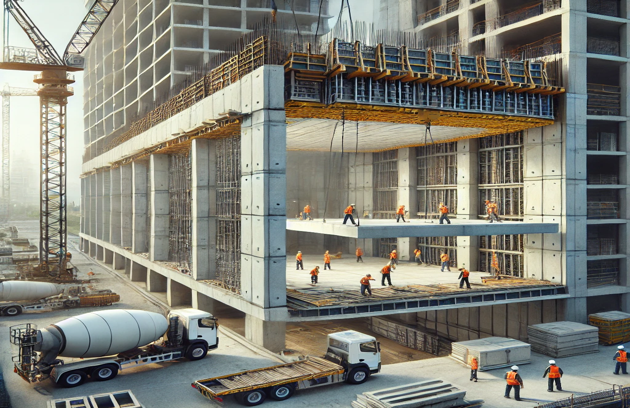The construction landscape has perennially evolved, with revolutionary techniques taking centre stage to cater to the dynamically changing requirements of speed, durability, and cost-effectiveness. One such method that has earned significant attention within the industry is concrete tilt panel construction. This innovative approach is revolutionising how commercial and industrial buildings are developed, offering myriad benefits that warrant a deep delve into its application and strengths.
Comprehending Concrete Tilt Panel Construction
Before looking at the advantages, one should first know what concrete tilt panel construction is. Using prefabricated concrete panels, either on-site or off-site, tilt panel construction forms the walls of a building by means of crane assistance. This effective method produces strong, long-lasting buildings, which appeals to many building projects.
Ease of Design and Customisation
One of the standout advantages of concrete tilt panel construction is the ease with which designs can be tailored to meet specific requirements. Due to the flexibility in design, architects and engineers can work collaboratively to create customised panels that align with the unique architectural vision and structural integrity demanded by the client.
Accelerated Construction Timeline
The speed at which buildings can be erected using tilt panel construction is a substantial benefit. The panels can be manufactured concurrently with site and foundation work, reducing overall time frames. This simultaneous process streamlines the construction phase, resulting in quicker project delivery and a significant reduction in labour costs.
Cost-Effectiveness
One advantage of this building technique is cost savings. Less work is involved with shorter building times. Furthermore, providing long-term value for the investment, concrete tilt panels’ natural energy efficiency can help reduce running expenses during the structure’s lifetime.
Thermal Efficiency and Insulation
Concrete’s inherent ability to be used for thermal mass helps to control internal temperature, hence increasing the energy efficiency of buildings. The excellent insulating qualities of concrete tilt panel construction help to minimise the demand for large-scale heating and cooling systems, promoting energy conservation and sustainability.
Robustness and Durability
Concrete is renowned for its robustness, and tilt panel construction is no exception. The resulting structures are resilient against extreme weather, fire, and wear and tear, ensuring they last for decades with minimal maintenance. This makes tilt panel buildings ideal for regions that experience harsh climatic conditions or for industries that require durable facilities.
Improved Safety Onsite
Another critical advantage of using tilt panels is the enhanced safety it affords. Most of the panel manufacturing takes place on the ground, which diminishes the risk of working at heights. In an industry where safety is paramount, this construction method significantly reduces the chance of accidents and injuries during the construction phase.
Environmental Sustainability
Tilt panel construction is advantageous from an environmental sustainability standpoint as well as from a cost and efficiency standpoint. Concrete panels are recyclable, and manufacturers can use recycled materials, reducing environmental impact. Furthermore, the structures’ energy efficiency lowers greenhouse gas emissions, therefore supporting the credentials of tilt panel architecture as a green solution.
Superior Acoustic Performance
Acoustic insulation is yet another advantage. The density of concrete provides exceptional acoustic barriers, making tilt panel buildings remarkably quiet inside, an essential factor for environments such as schools, offices, or residential complexes where noise reduction is important.
Low Maintenance Requirements
In addition to being cost-effective in terms of construction, concrete tilt panel buildings require little in the way of ongoing maintenance. This is because concrete is such a resistant material; it does not suffer easily from wear or degradation. The lack of structural steel minimises the risk of corrosion, further limiting the need for repairs and replacements.
Aesthetic Flexibility
Against popular belief, tilt panel designs are not always utilitarian or depressing in appearance. Modern advancements give a variety of treatments, colors, and textures that can transform concrete tilt panels into attractive design elements, therefore offering aesthetic variation to meet even the most rigorous architectural needs.
Optimised Construction Practices
The systematic nature of tilt panel construction allows for optimised procedures and control. Prefabricating panels in a controlled environment can increase the precision and quality of the construction elements. Furthermore, less waste is generated on site, and materials can be managed more effectively during the production phase.
Adaptability and Continuity
Tilt panel construction offers adaptability to future changes or expansions. Should a business grow or require modifications to its premises, concrete panels can be designed with future alterations in mind, enabling continuity of the original construction while evolving with the organisation’s needs.
Conclusion
To summarize, concrete tilt panel construction offers a number of compelling advantages for the construction business. From its amazing architectural adaptability to its expedited construction timeframes, economy, and environmental sustainability, it is evidence of building technique innovation. Concrete tilt panel building is expected to become increasingly more important in the field of modern building as construction needs change and sustainability-efficient, durable building techniques take center stage.
Fostering New Possibilities Through Innovation
Adopting concrete tilt panel constructions allows one to create fresh opportunities in building techniques fit for modern needs. These approaches will be the basis for future developments as the sector keeps innovating, balancing environmental, aesthetic, and practical goals.
Also Read:


